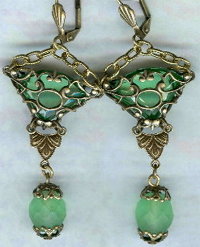I share this experience with you in an attempt to help you cope with this frustrating event in the most positive way I know.
From the first time a cave dweller made a mark on the wall with a piece of charcoal, I have a feeling there has been this claim of “She’s copying me!”

When I made jewelry full time, I was widely and blatantly copied. Each time I realized my work was being duplicated, I moved on to learn a new technique, try a new method and experiment with a different style. I didn’t waste time and energy lamenting that someone was trying to copy me. It forced me to become a much more accomplished artist.
I am in no way endorsing such actions, however if I had never had competition, I would still be living in a small townhouse in Virginia Beach, working two jobs and making Friendly Plastic jewelry. Those of you who realize the value of competition, rise above the masses and go on to accomplish all that you are capable of. I am almost grateful for those women who came to every show, went through my trash trying to find out where I bought something and stood in front of display cases in boutiques taking notes.
Today I employee several people and help to sustain many small businesses and families. In part, I credit my success to those early copy-cats who forced me to learn more.
If you find that a designer has made something similar to your work and then prices it below your fair-market price, keep in mind that underpricing the items you make, can and will put you out of business very quickly. When you don’t factor in enough profit to replenish your supplies and pay yourself at least a little for your time and creative energy, you will not continue to make and sell jewelry.
Let’s face the truth. Stealing someone’s idea or design and passing it off as yours is plagiarism. Not only is it wrong, it can get you sued. The following segment was taken from the web site Plagiarism.org.
What is Plagiarism?
Many people think of plagiarism as copying another’s work, or borrowing someone else’s original ideas. But terms like “copying” and “borrowing” can disguise the seriousness of the offense:
According to the Merriam-Webster Online Dictionary, to “plagiarize” means
- to steal and pass off (the ideas or words of another) as one’s own
- to use (another’s production) without crediting the source
- to commit literary theft
- to present as new and original an idea or product derived from an existing source.
In other words, plagiarism is an act of fraud. It involves both stealing someone else’s work and lying about it afterward.
But can words and ideas really be stolen?
According to U.S. law, the answer is yes. The expression of original ideas is considered intellectual property, and is protected by copyright laws, just like original inventions. Almost all forms of expression fall under copyright protection as long as they are recorded in some way (such as a book or a computer file).
All of the following are considered plagiarism:
- turning in someone else’s work as your own
- copying words or ideas from someone else without giving credit
- failing to put a quotation in quotation marks
- giving incorrect information about the source of a quotation
- changing words but copying the sentence structure of a source without giving credit
- copying so many words or ideas from a source that it makes up the majority of your work, whether you give credit or not (see our section on “fair use” rules)
Most cases of plagiarism can be avoided, however, by citing sources. Simply acknowledging that certain material has been borrowed, and providing your audience with the information necessary to find that source, is usually enough to prevent plagiarism.
This segment includes legal steps you can take to stop people from copying you.
This paraphrased information is shared with us by Willie Zuniga.
Have you ever wondered why people add the “YourNameHere ©2009” statement at the end of every page? That is exactly what you are supposed to do. It states your intent to claim copyright, and will prevent people from assuming it’s all right to copy your work.
When your item is “published,” (magazine, book, Internet, photo) you automatically have limited protection simply by adding your copyright statement. If you ever have to go to court though, you need to have a registered copyright in order to collect monetary damages.
There are certain conditions that apply to jewelry, and frankly a lot of it won’t be accepted. There has to be a “creative use of the medium,” for example, simply gluing a cabochon into a setting isn’t going to pass as something you can copyright. But most of the wrapped, layered, detailed jewelry will … if not as jewelry then as sculpture. The cost to apply for a copyright ranges from $35-50, and often a collection of related items can be registered for a single fee.
This is an easy to read article which explains copyright as pertains to jewelry….
http://www.firemountaingems.com/printdocs/printdocs.asp?docid=WTHTCPYRGHTSWHRWLDWB
You can also refer to the government website to learn all the facts:
http://www.copyright.gov/
This is where you can apply electronically:
http://www.copyright.gov/register/visual.html
We wish you success and happiness.
Susan
Visit our store web site VintageJewelrySupplies.com to shop for thousands of jewelry making items.
(NOTE: our website best viewed on desktop or tablet)